Chenning Li
Morph: ChirpTransformer-based Encoder-decoder Co-design for Reliable LoRa Communication
Jul 30, 2025Abstract:In this paper, we propose Morph, a LoRa encoder-decoder co-design to enhance communication reliability while improving its computation efficiency in extremely-low signal-to-noise ratio (SNR) situations. The standard LoRa encoder controls 6 Spreading Factors (SFs) to tradeoff SNR tolerance with data rate. SF-12 is the maximum SF providing the lowest SNR tolerance on commercial off-the-shelf (COTS) LoRa nodes. In Morph, we develop an SF-configuration based encoder to mimic the larger SFs beyond SF-12 while it is compatible with COTS LoRa nodes. Specifically, we manipulate four SF configurations of a Morph symbol to encode 2-bit data. Accordingly, we recognize the used SF configuration of the symbol for data decoding. We leverage a Deep Neural Network (DNN) decoder to fully capture multi-dimensional features among diverse SF configurations to maximize the SNR gain. Moreover, we customize the input size, neural network structure, and training method of the DNN decoder to improve its efficiency, reliability, and generalizability. We implement Morph with COTS LoRa nodes and a USRP N210, then evaluate its performance on indoor and campus-scale testbeds. Results show that we can reliably decode data at -28.8~dB SNR, which is 6.4~dB lower than the standard LoRa with SF-12 chirps. In addition, the computation efficiency of our DNN decoder is about 3x higher than state-of-the-art.
KramaBench: A Benchmark for AI Systems on Data-to-Insight Pipelines over Data Lakes
Jun 06, 2025Abstract:Constructing real-world data-to-insight pipelines often involves data extraction from data lakes, data integration across heterogeneous data sources, and diverse operations from data cleaning to analysis. The design and implementation of data science pipelines require domain knowledge, technical expertise, and even project-specific insights. AI systems have shown remarkable reasoning, coding, and understanding capabilities. However, it remains unclear to what extent these capabilities translate into successful design and execution of such complex pipelines. We introduce KRAMABENCH: a benchmark composed of 104 manually-curated real-world data science pipelines spanning 1700 data files from 24 data sources in 6 different domains. We show that these pipelines test the end-to-end capabilities of AI systems on data processing, requiring data discovery, wrangling and cleaning, efficient processing, statistical reasoning, and orchestrating data processing steps given a high-level task. Our evaluation tests 5 general models and 3 code generation models using our reference framework, DS-GURU, which instructs the AI model to decompose a question into a sequence of subtasks, reason through each step, and synthesize Python code that implements the proposed design. Our results on KRAMABENCH show that, although the models are sufficiently capable of solving well-specified data science code generation tasks, when extensive data processing and domain knowledge are required to construct real-world data science pipelines, existing out-of-box models fall short. Progress on KramaBench represents crucial steps towards developing autonomous data science agents for real-world applications. Our code, reference framework, and data are available at https://github.com/mitdbg/KramaBench.
m4: A Learned Flow-level Network Simulator
Mar 03, 2025Abstract:Flow-level simulation is widely used to model large-scale data center networks due to its scalability. Unlike packet-level simulators that model individual packets, flow-level simulators abstract traffic as continuous flows with dynamically assigned transmission rates. While this abstraction enables orders-of-magnitude speedup, it is inaccurate by omitting critical packet-level effects such as queuing, congestion control, and retransmissions. We present m4, an accurate and scalable flow-level simulator that uses machine learning to learn the dynamics of the network of interest. At the core of m4 lies a novel ML architecture that decomposes state transition computations into distinct spatial and temporal components, each represented by a suitable neural network. To efficiently learn the underlying flow-level dynamics, m4 adds dense supervision signals by predicting intermediate network metrics such as remaining flow size and queue length during training. m4 achieves a speedup of up to 104$\times$ over packet-level simulation. Relative to a traditional flow-level simulation, m4 reduces per-flow estimation errors by 45.3% (mean) and 53.0% (p90). For closed-loop applications, m4 accurately predicts network throughput under various congestion control schemes and workloads.
DriveTrack: A Benchmark for Long-Range Point Tracking in Real-World Videos
Dec 15, 2023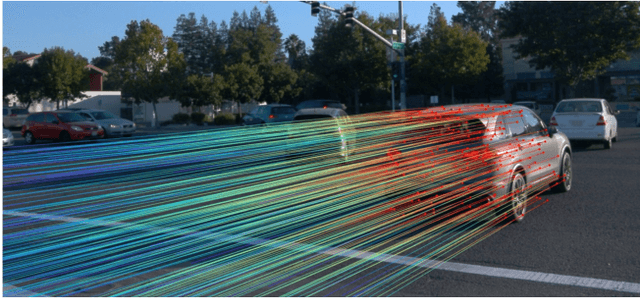
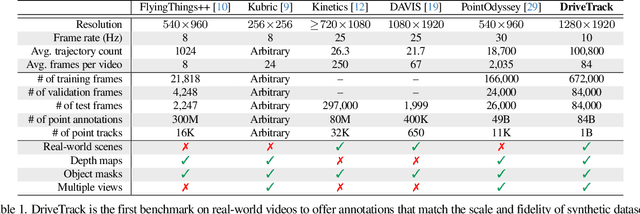
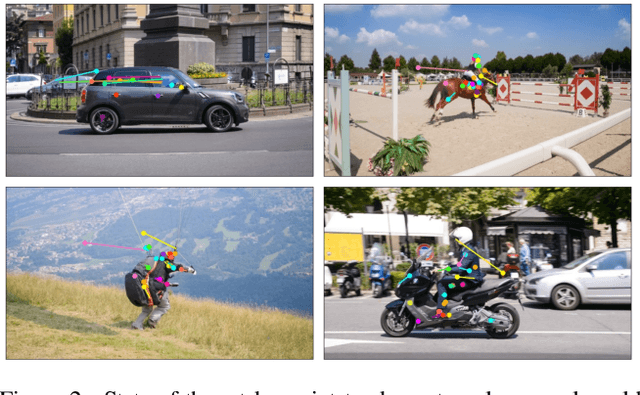
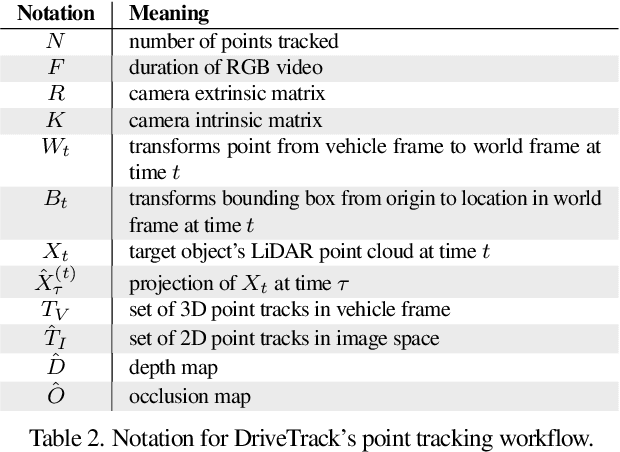
Abstract:This paper presents DriveTrack, a new benchmark and data generation framework for long-range keypoint tracking in real-world videos. DriveTrack is motivated by the observation that the accuracy of state-of-the-art trackers depends strongly on visual attributes around the selected keypoints, such as texture and lighting. The problem is that these artifacts are especially pronounced in real-world videos, but these trackers are unable to train on such scenes due to a dearth of annotations. DriveTrack bridges this gap by building a framework to automatically annotate point tracks on autonomous driving datasets. We release a dataset consisting of 1 billion point tracks across 24 hours of video, which is seven orders of magnitude greater than prior real-world benchmarks and on par with the scale of synthetic benchmarks. DriveTrack unlocks new use cases for point tracking in real-world videos. First, we show that fine-tuning keypoint trackers on DriveTrack improves accuracy on real-world scenes by up to 7%. Second, we analyze the sensitivity of trackers to visual artifacts in real scenes and motivate the idea of running assistive keypoint selectors alongside trackers.
WiVelo: Fine-grained Walking Velocity Estimation for Wi-Fi Passive Tracking
Jul 28, 2022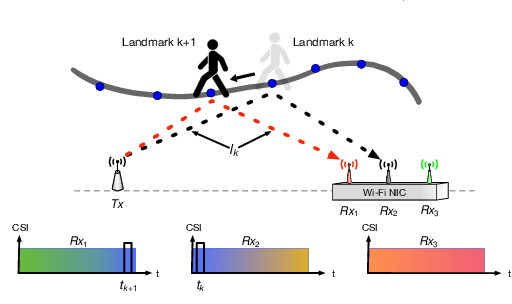
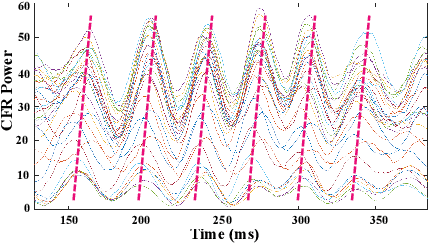
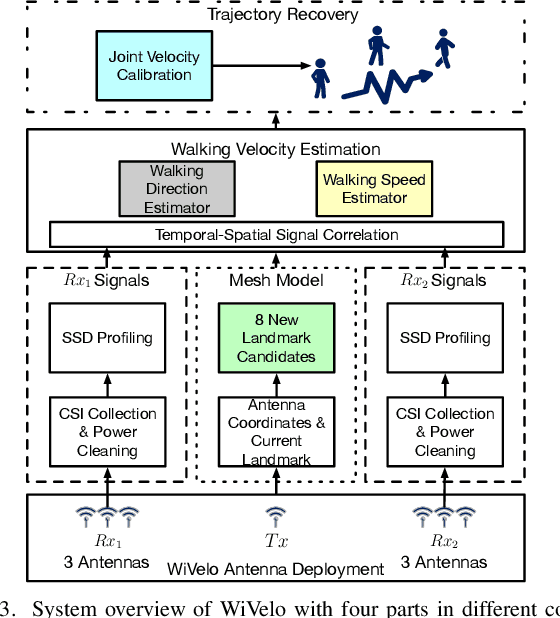
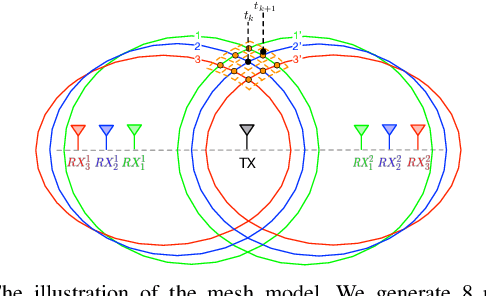
Abstract:Passive human tracking via Wi-Fi has been researched broadly in the past decade. Besides straight-forward anchor point localization, velocity is another vital sign adopted by the existing approaches to infer user trajectory. However, state-of-the-art Wi-Fi velocity estimation relies on Doppler-Frequency-Shift (DFS) which suffers from the inevitable signal noise incurring unbounded velocity errors, further degrading the tracking accuracy. In this paper, we present WiVelo\footnote{Code\&datasets are available at \textit{https://github.com/liecn/WiVelo\_SECON22}} that explores new spatial-temporal signal correlation features observed from different antennas to achieve accurate velocity estimation. First, we use subcarrier shift distribution (SSD) extracted from channel state information (CSI) to define two correlation features for direction and speed estimation, separately. Then, we design a mesh model calculated by the antennas' locations to enable a fine-grained velocity estimation with bounded direction error. Finally, with the continuously estimated velocity, we develop an end-to-end trajectory recovery algorithm to mitigate velocity outliers with the property of walking velocity continuity. We implement WiVelo on commodity Wi-Fi hardware and extensively evaluate its tracking accuracy in various environments. The experimental results show our median and 90\% tracking errors are 0.47~m and 1.06~m, which are half and a quarter of state-of-the-arts.
NEC: Speaker Selective Cancellation via Neural Enhanced Ultrasound Shadowing
Jul 12, 2022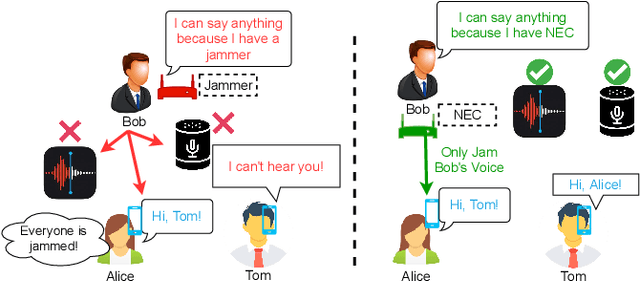
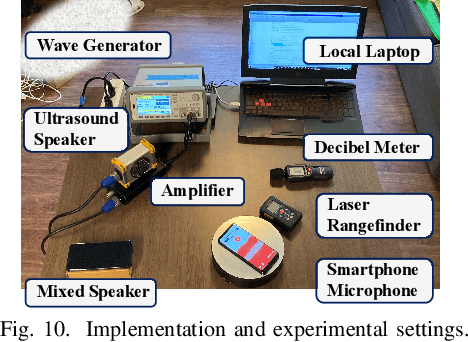

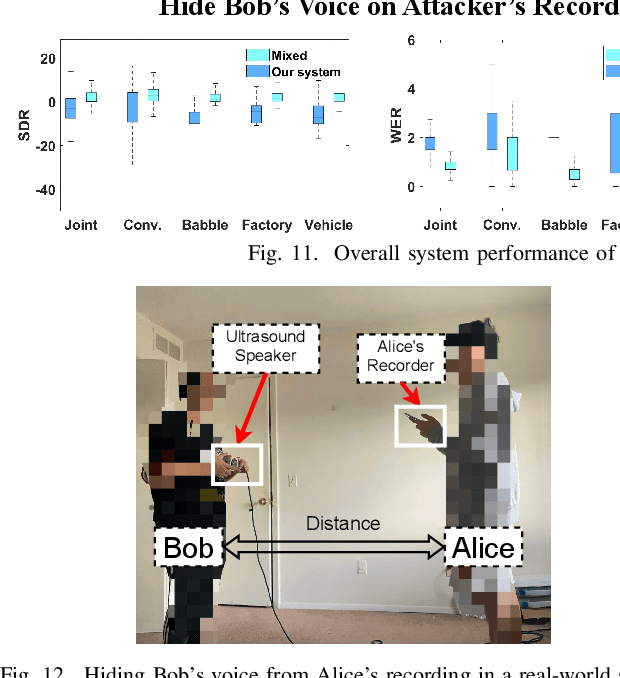
Abstract:In this paper, we propose NEC (Neural Enhanced Cancellation), a defense mechanism, which prevents unauthorized microphones from capturing a target speaker's voice. Compared with the existing scrambling-based audio cancellation approaches, NEC can selectively remove a target speaker's voice from a mixed speech without causing interference to others. Specifically, for a target speaker, we design a Deep Neural Network (DNN) model to extract high-level speaker-specific but utterance-independent vocal features from his/her reference audios. When the microphone is recording, the DNN generates a shadow sound to cancel the target voice in real-time. Moreover, we modulate the audible shadow sound onto an ultrasound frequency, making it inaudible for humans. By leveraging the non-linearity of the microphone circuit, the microphone can accurately decode the shadow sound for target voice cancellation. We implement and evaluate NEC comprehensively with 8 smartphone microphones in different settings. The results show that NEC effectively mutes the target speaker at a microphone without interfering with other users' normal conversations.
 Add to Chrome
Add to Chrome Add to Firefox
Add to Firefox Add to Edge
Add to Edge